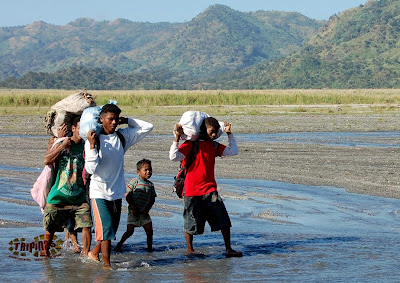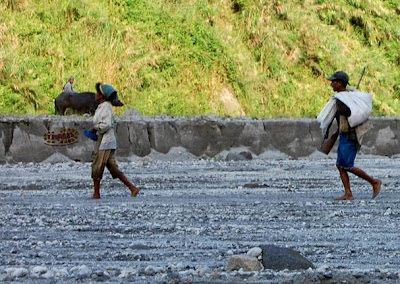The Aetas are considered the Philippine archipelago's first inhabitants¹. No one is really certain where they were orginally from nor how they arrived in the Philippines. One popular theory is that Pinatubo ancestors used land bridges at the time when sea levels were low to move here. They were said to have been occupying the island of Luzon since 28000 BC until they were displaced by latter wave of migrants (Austronesian Fiipinos). The Aetas then moved to the highlands with the biggest group found in the slopes of Mt. Pinatubo².
Aetas are short, typically dark-skinned and have curly hair. They are semi-nomadic people who have been accustomed to foraging. Unlike their lowland counterpart, they are more of hunter-gatherers (mostly of non-timber producst) than farmers. As time passed, they started using slash-and-burn cultivation as well to ensure their food supply ³.
Young Aetas transporting goods
Even though majority of the Pinatubo Aetas were somewhat Christian at the time of the eruption, they still saw and did things using their pre-Christian beliefs. In fact, they regarded Pinatubo as “the center of the universe, home of the spirits and, for some, a resting place for the soul of the deceased” (Reilly, Benjamin. Disaster and human history: case studies in nature, society and catastrophe, 2009). The most important spirit is Apo Namalyari, thought to be as the creator of everyting.
Your Pinatubo guide is often an Aeta
The eruption of Mount Pinatubo affected greatly the Aeta community living on its slopes and made around 20, 000 of them homeless. Initially they were adamant on leaving their place. Pinatubo is everything to them – their habitat and spiritual realm. They didn't really see the re-awakeing of the mountain as a natural phenomenon but rather a proof of Apo Namalyari's power and anger. The Pinatubo Aetas were convinced that Apo Namalyari was angered by the recent drilling to build a geothermal plant².
Visiting Mt. Pinatubo will also be the opportunity to meet the very first inhabitants of the Philippines!
Sources:
1. Ganeri, Anita. Volcanoes in Action (Natural Disasters in Action). Ed. Susie Brooks. New York: The Rosen Publishing Group Inc., 2009.
2. Reilly, Benjamin, Disaster and human history: case studies in nature, society and catastrophe. 2nd ed. North Carolina: McFarlan & Company Inc., 2009
3. Culture and the Changing Environment: Uncertainty, Cognition and Risk Management in Cross-Cultural Prospective. Ed. Michael J. Casiri. Berghahn Books, 2009.
Check our Pinatubo trekking package here!

